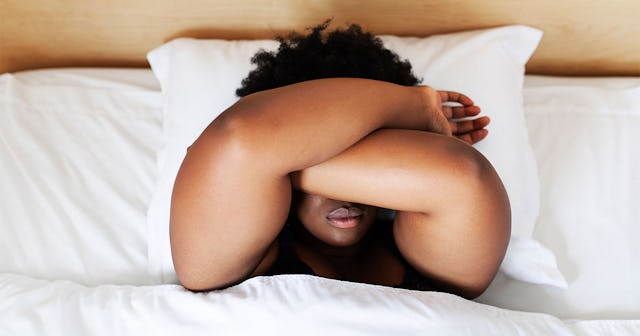3 Things To Remember When You Hit A Pandemic Wall

Things were supposed to be better by now. Earlier this year, the vaccines arrived, and they were more effective than any of us could have dreamed. Infection numbers were slowly decreasing and the burden on the hospitals was beginning to ease—in most parts of the country, anyway. We were within arm’s reach of the light at the end of the tunnel. And then Omicron—a variant that evades vaccines, that is more transmissible than the previously more transmissible Delta variant—shows up. Instead of reaching for that end-of-tunnel-light, many of us are running full-speed, head and heart first, into yet another pandemic wall.
And oh, this one hurts.
This wall feels different than the other walls. It’s more jagged. More dense. It reeks of disappointment and resentment and shattered dreams. (That might be a little dramatic, but it’s also fair. A week ago, Omicron accounted for only 13 percent of COVID cases. As of this writing, it accounts for 73 percent — just in time for the holidays.)
This wall feels like surrender. From this particular pandemic wall, the future looks bleak and it’s hard to believe that we’ll ever reach that light at the end of the tunnel.
If you’ve hit this particular pandemic wall, you know exactly what I’m talking about. Chances are if you’ve hit this pandemic wall, you’re familiar with pandemic walls. Maybe you hit one last year around this time. Maybe right as Delta swooped in.
Either way, you know the advice from experts—to get enough sleep, to eat, to connect with friends and family in ways that feel safe.
In addition to all of that good advice there are a few other things to keep in mind as you scrape your shattered dreams from the wall to try and make this one a little less jagged.
First, remember that as much as this feels like March 2020 all over again, it’s absolutely not. We’re in a very different place now than we were then.
One big reason for that is: vaccines. Yes, Omicron seems to evade vaccine and natural immunity better than previous variants. Yes, that means we’re again susceptible to infection. And yes, all of that is awful. But—and yay for a but—experts believe that the vaccines will still be excellent at protecting us from severe disease, hospitalization, and death. Ultimately, that’s the goal.
Also, we understand the virus, at least more than we did way back in March 2020. We understand how it’s transmitted. Gone are the days (for most of us) of wiping down groceries and Lysol-ing Amazon deliveries. We now know that COVID isn’t surface transmissible. We know how it’s transmitted and what factors increase transmissibility. That’s important because it means we can take actions to decrease transmissibility—going outdoors, proper ventilation, and masks. Which means—we’re not as helpless as we once were.
Second, we have tests, which means we don’t have to live with uncertainty.
Remember way back in March 2020 when tests were scarce? When every sniffle felt like COVID and you couldn’t tell if you were allergic to pollen or coming down with a deadly virus? When the only way to get a test was to wait in a drive through line and get swabbed by a person in a hazmat suit?
Yesterday, I tested my kids at home. While they were watching Netflix.
It might seem like a nothing, but the ability to know—within minutes or days—whether that sniffle is a sniffle or something more is glimmer of light shining through this pandemic wall.
Third, keep in mind that it’s okay to hit a pandemic wall.
There’s no shame in admitting you’ve hit a pandemic wall—whether for the third time or the hundred and third time. We’ve all hit at least one pandemic wall. (I’d venture to guess most of us have hit more than one pandemic wall.)
“We need to have grace with ourselves and the folks around us,” Ariane Thomas a clinical psychologist and lecturer at the University of Pennsylvania, told Vox, “because no one is doing this perfectly.”
Part of having grace is also acknowledging how awful this all is and accepting that we don’t know what to do. We’re all whiplashed by the sudden surge after just beginning to feel safe. We’re all exhausted from the minute-by-minute decision-making we’ve all had to do because of the pandemic.
“Giving up this responsibility of knowing what to do or to fix things relieves us from some of the burden of things not going right,” according to Tamar Rodney, a professor and mental health nurse practitioner at Johns Hopkins School of Nursing in an interview Vox.
No one can promise it’ll get better. There’s a kind of freedom in admitting that.
And If None Of That Makes This Pandemic Wall A Little Less Jagged…
Anytime I write about reasons to feel hopeful during the pandemic, I do so with an asterisk. Everyone’s pandemic wall looks different. There are so many different versions of pandemic walls, some of which are built on a foundation of long COVID, loss, financial hardship—to name only a few. Giving reasons to stay positive or hopeful in the face of all that can be minimizing, at best, and invalidating, at worst.
For those of us whose pandemic walls are not at all soothed by words, who aren’t calmed by the knowledge that we’re not back at square one, maybe the thing to remember is this: you’re more than a pandemic wall, even an exceptionally dense and jagged one. And that matters.
This article was originally published on